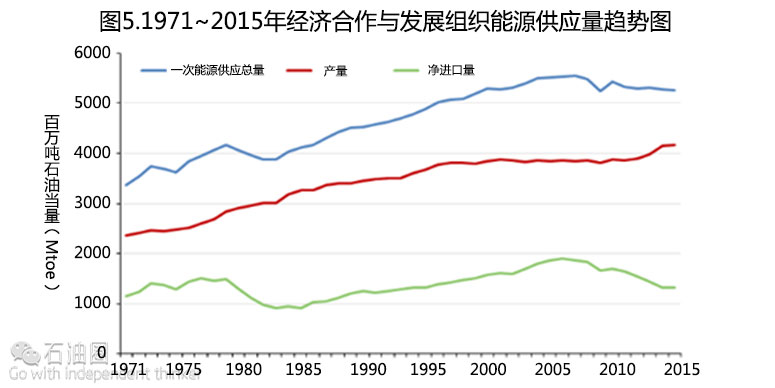Reflecting the IEA’s increasingly global perspective, for the first time the Agency’s OECD and non-OECD Energy Balances and Statistics reports have been merged into two comprehensive global reports on energy data. World Energy Balances and World Energy Statistics will contain detailed data on over 150 countries and regions and will be released in full at the end of August 2016.
These reports show that world energy production reached 13 800 million tonnes of oil equivalent (Mtoe) in 2014, up 1.5% from 2013. Fossil fuels accounted for 81% of this production – 0.4% lower than in 2013 – in spite of rising oil (+2.1%), coal (+0.8%) and natural gas production (+0.6%), as production of renewables grew even faster. For example Hydro production was up 2.5% and accounted for 2.4% of global production while wind and solar PV continued their fast growth (+11% and +35% respectively), and accounted for around 1% of global energy production. Among non-fossil sources, biofuels and waste accounted for 10.2% of world energy production in 2014 and nuclear slightly increased its share to 4.7%.
While restricted to primary fossil fuels, preliminary 2015 global country level production data show a clear slowdown in the growth of fossil fuel production, only 0.5% higher than in 2014. While crude oil and natural gas production increased at a higher rate than in 2014 (+3.0% and +1.6% respectively), a 3.1% fall in coal production over the same period resulted in an overall slowdown in growth.
The reports also highlight the significant changes in regional energy demand that have taken place over the past 40 years. In 1971 OECD (including Japan and Korea) and the rest of Asia (including China) together accounted for almost three quarters of energy usage, with OECD demand four times greater than that of Asia. Yet while the combined energy share of these regions remained at around three quarters of the global total in 2014, the proportions changed drastically; OECD and Asia became broadly comparable, at 38% and 35% respectively.
This drop in the OECD’s share of global total primary energy supply – or TPES, a measure of total energy use both in transformation and final use – from 61% in 1971 to 38% in 2014 reflects the fact that since 1971, annual average growth in TPES in Asia was above 5% for all fuels except biomass – significantly above the average global increase.
This increase in demand for energy in Asia has been driven by consumers, with final consumption in the region increasing five-fold over four decades. Coal remains the most consumed fuel, with approximately the same share in 1971 and 2014 (29% and 28% respectively). However the rest of the mix is seeing rapid change. The share of oil in total final consumption almost doubled (from 15% to 28%), while electricity rose from 3% to 19%. Following a seven-fold increase, industry was by far the greatest energy consuming sector in Asia in 2014, representing 42% of the region’s total final consumption, largely fueled by coal. The residential sector followed industry in energy use, having seen a 120% increase between 1971 and 2014. Traditional biomass was still the main fuel consumed by households, while electricity and natural gas consumption also increased significantly. Energy consumption grew 12-fold in the transport sector, and continued to rely mainly on oil.
Globally, total consumption more than doubled between 1971 and 2014. However the sectoral breakdown of energy use did not change dramatically. Industry remained the largest consuming sector in 2014, only one percentage point lower than in 1971 (37%), followed by transport (28%), a 5% increase on 1971 figures, and residential (23%).
Looking solely at OECD countries, where provisional data are available for 2015, energy production hit 4 164 Mtoe in 2015, a 0.5% increase on 2014 figures, and the highest level since the IEA was founded in 1974. Exports were also the highest ever recorded at 1 790 Mtoe (+5.5% from 2014). Following three consecutive years of decline, imports increased by 3.2%, with net imports remaining broadly stable in the region compared to 2014. OECD total primary energy supply remained stable in 2015, coming in at 5 269 Mtoe, only 0.1% less than in 2014.
In terms of the fuel mix, the OECD increased its use of oil (36% of TPES, +1%) and natural gas (26% of TPES, +2%) in 2015. Nuclear (10% of TPES) remained stable, with Asia-Oceania increasing its use while Europe decreased. Other sources (10% of TPES) increased by 2%, mainly due to renewables. Significantly, there was a drop of 15% in the United States of coal use over 2014 figures. In 2015, more than 200 TWh of electricity came from natural gas, driving a 6% decrease in the OECD region’s overall coal demand.
With production increasing more than energy use, the level of self-sufficiency (defined as production/TPES) in the OECD increased to 79% in 2015, a figure comparable to the high levels of 1985. Notably, in 2015, OECD Americas became self-sufficient for the first time since the IEA was founded, with the United States not far behind at 93%. This is in contrast with the levels observed in OECD Europe and OECD Asia Oceania, both coming in at below 60%.


 石油圈
石油圈







